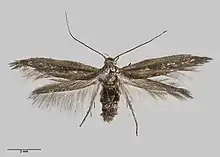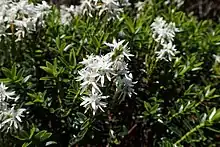Scythris nigra
Scythris nigra is a species of moth in the family Scythrididae first described by Alfred Philpott in 1931.[1] It is endemic to New Zealand. The larvae of this species feeds on Hebe odora. The adults are day flying and on the wing in December.
| Scythris nigra | |
|---|---|
 | |
| Male holotype | |
| Scientific classification | |
| Domain: | Eukaryota |
| Kingdom: | Animalia |
| Phylum: | Arthropoda |
| Class: | Insecta |
| Order: | Lepidoptera |
| Family: | Scythrididae |
| Genus: | Scythris |
| Species: | S. nigra |
| Binomial name | |
| Scythris nigra Philpott, 1931 | |
Taxonomy
This species was first described by Alfred Philpott in 1931 using specimens collected on Maungatua in December by C. E. Clarke.[2] The male holotype specimen is held at the Auckland War Memorial Museum.[3]
Description
.jpg.webp)
Philpott described this species as follows:
♂. 12 mm. Head, palpi, abdomen and thorax dark purplish fuscous. Antennae purplish fuscous, ciliations in ♂ ½. Legs dark purplish fuscous, tarsi without annulations. Forewings with costa moderately arched, bent at ⅓, apex acute, termen extremely oblique; dark purplish fuscous sparsely sprinkled with white scales: fringes dark fuscous. Hindwings and fringes dark fuscous.[2]
This species can be distinguished from the similar appearing S. triatma as it has a much darker appearance and lacks the bluish-slate colour that can be seen on the fore-wings of S. triatma.[4]
Distribution
This species is endemic to New Zealand and has been observed in the lower parts of the South Island.[5][4]
Habitat and hosts

S. nigra normally lives in alpine habitats however it can be also found at relatively low altitudes such as at Waitahuna Hill]] near Lake Mahinerangi.[7] The larvae of this species feed on Hebe odora.[8]
References
- Gordon, Dennis P., ed. (2010). New Zealand inventory of biodiversity: Kingdom animalia : chaetognatha, ecdysozoa, ichnofossils. Vol. 2. p. 463. ISBN 978-1-877257-93-3. OCLC 973607714. OL 25288394M. Wikidata Q45922947.
- Alfred Philpott (1931). "Notes and descriptions of New Zealand Lepidoptera". Transactions and Proceedings of the New Zealand Institute. 62: 31. ISSN 1176-6158. Wikidata Q109466059.
- John Stewart Dugdale (23 September 1988). "Lepidoptera - annotated catalogue, and keys to family-group taxa". Fauna of New Zealand. Department of Scientific and Industrial Research. 14: 110. doi:10.7931/J2/FNZ.14. ISSN 0111-5383. Wikidata Q45083134.
- George Vernon Hudson (1939), A supplement to the butterflies and moths of New Zealand, Illustrator: George Hudson, Wellington, p. 459, OCLC 9742724, Wikidata Q109420935
{{citation}}: CS1 maint: location missing publisher (link) - "Scythris nigra Philpott, 1931". www.nzor.org.nz. Retrieved 2022-05-05.
- Brian Patrick (1 December 2014). "Conservation status of five data deficient moth taxa: Epichorista lindsayi, "Cnephasia" paterna, Stathmopoda endotherma, Gymnobathra ambigua and Scythris "stripe"". The Wētā. 48: 15–34. ISSN 0111-7696. Wikidata Q105343576.
- Department of Conservation (New Zealand) (2016). CMS, conservation management strategy. Otago 2016 (PDF). Christchurch: Department of Conservation. p. 94. ISBN 978-0-478-15089-6. OCLC 978282663.
- K. J. M. Dickinson; A. F. Mark; B. I. P. Barratt; B. H. Patrick (March 1998). "Rapid ecological survey, inventory and implementation: a case study from Waikaia Ecological Region, New Zealand". Journal of the Royal Society of New Zealand. 28 (1): 142. doi:10.1080/03014223.1998.9517556. ISSN 0303-6758. Wikidata Q54578259.